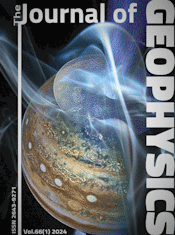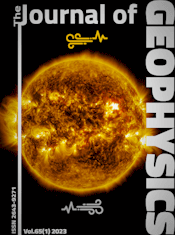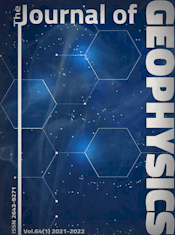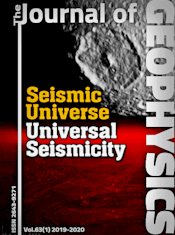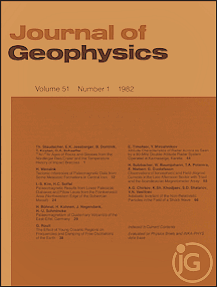The normal modes of a layered, incompressible Maxwell half-space
Article Sidebar

Vols. 1-18 (1924-1944), ISSN 0044-2801
Main Article Content
Abstract
The theory describing the relaxation of an incompressible, layered Maxwell half-space is developed. The approach is based on the analytic solution of the associated elastic model and the subsequent application of the correspondence principle. The viscoelastic theory follows normal-mode theory, which allows the independent and exact determination of the relaxation-time and amplitude spectra for each mode of relaxation. The solution is tested by calculating the response of several models in the wavenumber and spatial domains. The examples are selected with regard to postglacial adjustment in Fennoscandia and analyse effects caused by (a) varying lithospheric thickness, (b) adding an asthenosphere, (c) increasing lower-mantle viscosity, (d) permitting relaxation of the lower lithosphere or (e) introducing density contrasts at 400-km and 670-km depths.
 ARK: https://n2t.net/ark:/88439/y058111
ARK: https://n2t.net/ark:/88439/y058111
Permalink: https://geophysicsjournal.com/article/245
Article Details
References
Beaumont, C. (1978) The evolution of sedimentary basins on a viscoelastic lithosphere: theory and examples. Geophys. J. R. Astron. Soc. 55:471-497
Cathi es, L.M. (1975) The viscosity of the Earth's mantle. Princeton University Press
Courtney, R.C. (1982) On the rheology of the oceanic and continental lithospheres. M.Sc. thesis, Dalhousie University
Dziewonski, A.M., Anderson, D.L. (1981) Preliminary reference Earth model. Phys. Earth Planet. Inter. 25:297-356
Farrell, W.E. (1972) Deformation of the Earth by· surface loads. Rev. Geophys. Space Phys. 10:761-797
Imbrie, J., Imbrie, K.P. (1979) Ice ages: solving the mystery. Enslow, Hillside
Kuo, J.T. (1969) Static response of a multilayered medium under inclined surface loads. J. Geophys. Res. 74:3195-3207
Lambeck, K., Nakiboglu, S.M. (1980) Seamount loading and stress in the ocean lithosphere. J. Geophys. Res. 85:6403-6418
Lanczano, P. (1982) Deformations of an elastic Earth. Academic Press, New York
McConnell, R.K. jr. (1965) Isostatic adjustment in a layered Earth. J. Geophys. Res. 70:5171-5188
McConnell, R.K. jr. (1968) Viscosity of the mantle from relaxation time spectra of isostatic adjustment. J. Geophys. Res. 73:7089-7105
Nakiboglu, S.M., Lambeck, K. (1982) A study of the Earth's response to surface loading with application to Lake Bonneville. Geophys. J. R. Astron. Soc. 70:577-620
Parker, R.L. (1972) The rapid calculation of potential anomalies. Geophys. J. R. Astron. Soc. 31:447-455
Parsons, B.E. (1972) Changes in the Earth's shape. Ph.D. thesis, Cambridge University
Peltier, W.R. (1974) The impulse response of a Maxwell Earth. Rev. Geophys. Space Phys. 12:649-669
Peltier, W.R. (1976) Glacial-isostatic adjustment - II. The inverse problem. Geophys. J. R. Astron. Soc. 46:669-705
Peltier, W.R. (1982) Dynamics of the ice age Earth Adv. Geophys. 24:1-146
Peltier, W.R. (1985) The LAGEOS constraint on deep mantle viscosity: results from a new normal mode method for the inversion of viscoelastic relaxation spectra. J. Geophys. Res. (In press)
Peltier, W.R., Andrews, J.T. (1976) Glacial-isostatic adjustment - I. The forward problem. Geophys. J. R. Astron. Soc. 46:605-646
Sclater, J.G., Jaupart, C., Galson, D. (1980) The heat flow through oceanic and continental crust and the heat loss of the Earth. Rev. Geophys. Space Phys. 18:269-311
Tullis, J.A. (1979) High temperature deformation of rocks and minerals. Rev. Geophys. Space Phys. 17:1137-1154
Walcott, R.I. (1980) Rheological models and observational data of glacio-isostatic rebound. In: Morner, N.-A. (Ed.) Earth rheology, isostasy, and eustasy. pp. 3-10. Wiley, New York
Ward, S.N. (1984) A note on lithospheric bending calculations. Geophys. J. R. Astron. Soc. 78:241-253
Weertman, J., Weertman, J.R. (1975) High temperature creep of rock and mantle viscosity. Annu. Rev. Earth Planet. Sci. 3:293-315
Wolf, D. (1984) The relaxation of spherical and flat Maxwell Earth models and effects due to the presence of the lithosphere. J. Geophys. 56:24-33
Wolf, D. (1985a) Thick-plate flexure re-examined. Geophys. J. R. Astron. Soc. 80:265-273
Wolf, D. (1985b) On Boussinesq's problem for Maxwell continua subject to an external gravity field. Geophys. J. R. Astron. Soc. 80:275-279
Wolf, D. (1985c) The normal modes of a uniform, compressible Maxwell half-space. J. Geophys. 56:100-105
Wolf, D. (1985d) An improved estimate of lithospheric thickness based on a reinterpretation of tilt data from Pleistocene Lake Algonquin. Can. J. Earth Sci. 22:768-773
Wu, P., Peltier, W.R. (1982) Viscous gravitational relaxation. Geophys. J. R. Astron. Soc. 70:435-485
Wu, P., Peltier, W.R. (1983) Glacial isostatic adjustment and the free-air gravity anomaly as a constraint on deep mantle viscosity. Geophys. J. R. Astron. Soc. 74:377-449



